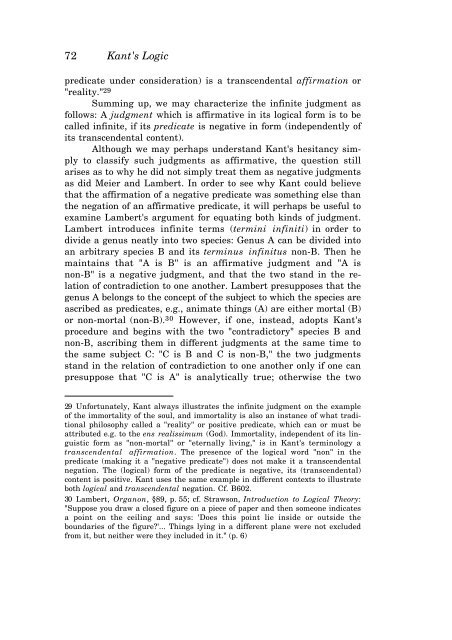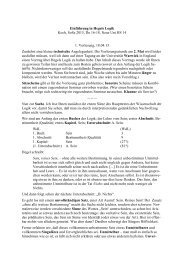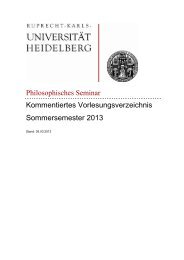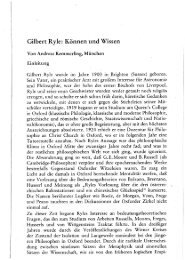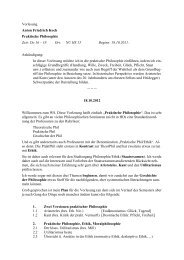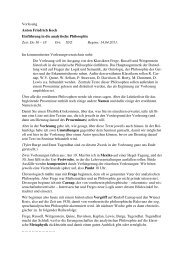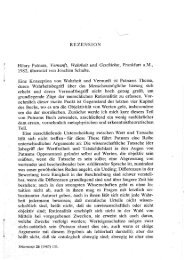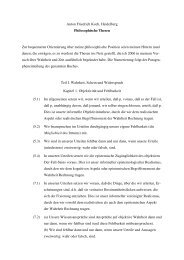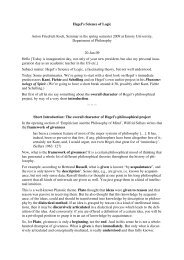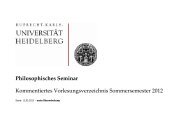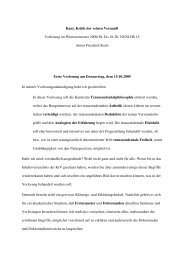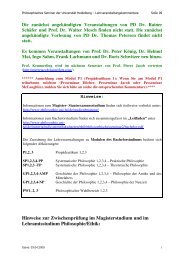KANT'S CRITIQUE OF TELEOLOGY IN BIOLOGICAL EXPLANATION
KANT'S CRITIQUE OF TELEOLOGY IN BIOLOGICAL EXPLANATION
KANT'S CRITIQUE OF TELEOLOGY IN BIOLOGICAL EXPLANATION
You also want an ePaper? Increase the reach of your titles
YUMPU automatically turns print PDFs into web optimized ePapers that Google loves.
72 Kant's Logic<br />
predicate under consideration) is a transcendental affirmation or<br />
"reality." 29<br />
Summing up, we may characterize the infinite judgment as<br />
follows: A judgment which is affirmative in its logical form is to be<br />
called infinite, if its predicate is negative in form (independently of<br />
its transcendental content).<br />
Although we may perhaps understand Kant's hesitancy simply<br />
to classify such judgments as affirmative, the question still<br />
arises as to why he did not simply treat them as negative judgments<br />
as did Meier and Lambert. In order to see why Kant could believe<br />
that the affirmation of a negative predicate was something else than<br />
the negation of an affirmative predicate, it will perhaps be useful to<br />
examine Lambert's argument for equating both kinds of judgment.<br />
Lambert introduces infinite terms (termini infiniti) in order to<br />
divide a genus neatly into two species: Genus A can be divided into<br />
an arbitrary species B and its terminus infinitus non-B. Then he<br />
maintains that "A is B" is an affirmative judgment and "A is<br />
non-B" is a negative judgment, and that the two stand in the relation<br />
of contradiction to one another. Lambert presupposes that the<br />
genus A belongs to the concept of the subject to which the species are<br />
ascribed as predicates, e.g., animate things (A) are either mortal (B)<br />
or non-mortal (non-B). 30 However, if one, instead, adopts Kant's<br />
procedure and begins with the two "contradictory" species B and<br />
non-B, ascribing them in different judgments at the same time to<br />
the same subject C: "C is B and C is non-B," the two judgments<br />
stand in the relation of contradiction to one another only if one can<br />
presuppose that "C is A" is analytically true; otherwise the two<br />
29 Unfortunately, Kant always illustrates the infinite judgment on the example<br />
of the immortality of the soul, and immortality is also an instance of what traditional<br />
philosophy called a "reality" or positive predicate, which can or must be<br />
attributed e.g. to the ens realissimum (God). Immortality, independent of its linguistic<br />
form as "non-mortal" or "eternally living," is in Kant's terminology a<br />
transcendental affirmation. The presence of the logical word "non" in the<br />
predicate (making it a "negative predicate") does not make it a transcendental<br />
negation. The (logical) form of the predicate is negative, its (transcendental)<br />
content is positive. Kant uses the same example in different contexts to illustrate<br />
both logical and transcendental negation. Cf. B602.<br />
30 Lambert, Organon, §89, p. 55; cf. Strawson, Introduction to Logical Theory:<br />
"Suppose you draw a closed figure on a piece of paper and then someone indicates<br />
a point on the ceiling and says: 'Does this point lie inside or outside the<br />
boundaries of the figure?'... Things lying in a different plane were not excluded<br />
from it, but neither were they included in it." (p. 6)


